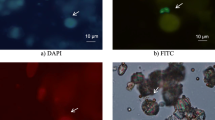Abstract
The cellulose-acetate membrane (CAM)-filter dissolution method implemented into a Millipore Glass Microanalysis system was used for recovery of Cryptosporidium parvum oocysts seeded into 25 l of drinking water in polyethylene carboy aspirator bottles. CAM-entrapped oocysts were detected by immunofluorescence microscopy. From 65 to 94 oocysts/l (mean 75 oocysts/l), 34.7% overall of the inoculated oocysts, were unrecovered as determined after the water had been drained from the bottle, rinsed with 1 l of eluting fluid (EF), and CAM-filtered. Efficiency rates of oocyst recovery ranged from 24.0% to 64.0% (mean 44.1%), without the use of EF and from 72.1% to 82.3% (mean 78.8%) when EF was used. To ensure a high recovery efficiency of Cryptosporidium oocysts from sampled water by the CAM-filter dissolution method, it is recommended that 1 l of EF per 25 l of water be used.
Similar content being viewed by others
Author information
Authors and Affiliations
Additional information
Received: 17 June 1996 / Accepted: 6 September 1996
Rights and permissions
About this article
Cite this article
Graczyk, T., Cranfield, M. & Fayer, R. Recovery of waterborne oocysts of Cryptosporidium from water samples by the membrane-filter dissolution method. Parasitol Res 83, 121–125 (1997). https://doi.org/10.1007/s004360050221
Issue Date:
DOI: https://doi.org/10.1007/s004360050221




